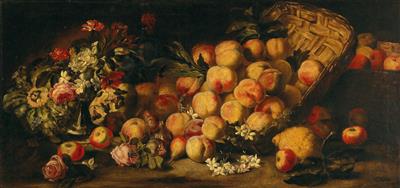Abraham Brueghel

(Antwerp 1631–1697 Naples)
Flowers, apples and peaches,
signed lower right: ABreughel: Fecit,
oil on canvas, 60.5 x 125 cm, framed
Provenance:
Private collection, Palermo
We are grateful to Fred Meijer for confirming the attribution of the present painting on the basis of a high resolution digital photograph.
The present painting which appears to be unpublished is a work by the Flemish Abraham Brueghel who was celebrated for his still life paintings. He remained devoted to the best work of his family’s artistic tradition.
Abraham was the son of Jan Brueghel the Younger (1601-1678) and the last exponent of this important dynasty of Flemish painters. Although he trained with his father in Antwerp, his cultural influences appear seemingly Italian, having spent almost his whole career in Italy. He began his career in Rome where he is documented from 1659, and was admitted as a member of the Accademia di San Luca, and later from 1676, he continued his career in Naples where he was to fully evolve his opulent and sumptuous style, playing an important role in the diffusion of the new figurative language of the Baroque. He collaborated with other artists including Carlo Maratta, Giovanni Battista Gaulli, il Baciccio and Giacinto Brandi, who executed the figures in some of his still life paintings.
Among his first and most committed supporters and protectors was the Sicilian Prince Antonio Ruffo. Abraham Brueghel’s style differs significantly from that of his predecessors on account of his lively and composed manner of painting, characterised by the use of warm colours and a soft painterly touch. It is an entirely personal style that is in dialogue with that of the Italian style of painting, and especially the Neapolitans Giovanni Battista Ruppolo and Giuseppe Recco. Indeed, in his still life paintings, such as the one presently under discussion, he is especially attentive to the composition of the work as a whole, rather than focusing on the description of individual details, which was more typical of the best Flemish tradition.
Represented in the present painting, within a carefully planned and spatially organised composition showing particular attention to the description of shape and volume, are peaches spilling over from an inclined basket at the right, figs, a vase of flowers and a pumpkin on the far left, all depicted with broad brush strokes, rich in impasto.
17.10.2017 - 18:00
- Prezzo realizzato: **
-
EUR 30.480,-
- Stima:
-
EUR 30.000,- a EUR 40.000,-
Abraham Brueghel
(Antwerp 1631–1697 Naples)
Flowers, apples and peaches,
signed lower right: ABreughel: Fecit,
oil on canvas, 60.5 x 125 cm, framed
Provenance:
Private collection, Palermo
We are grateful to Fred Meijer for confirming the attribution of the present painting on the basis of a high resolution digital photograph.
The present painting which appears to be unpublished is a work by the Flemish Abraham Brueghel who was celebrated for his still life paintings. He remained devoted to the best work of his family’s artistic tradition.
Abraham was the son of Jan Brueghel the Younger (1601-1678) and the last exponent of this important dynasty of Flemish painters. Although he trained with his father in Antwerp, his cultural influences appear seemingly Italian, having spent almost his whole career in Italy. He began his career in Rome where he is documented from 1659, and was admitted as a member of the Accademia di San Luca, and later from 1676, he continued his career in Naples where he was to fully evolve his opulent and sumptuous style, playing an important role in the diffusion of the new figurative language of the Baroque. He collaborated with other artists including Carlo Maratta, Giovanni Battista Gaulli, il Baciccio and Giacinto Brandi, who executed the figures in some of his still life paintings.
Among his first and most committed supporters and protectors was the Sicilian Prince Antonio Ruffo. Abraham Brueghel’s style differs significantly from that of his predecessors on account of his lively and composed manner of painting, characterised by the use of warm colours and a soft painterly touch. It is an entirely personal style that is in dialogue with that of the Italian style of painting, and especially the Neapolitans Giovanni Battista Ruppolo and Giuseppe Recco. Indeed, in his still life paintings, such as the one presently under discussion, he is especially attentive to the composition of the work as a whole, rather than focusing on the description of individual details, which was more typical of the best Flemish tradition.
Represented in the present painting, within a carefully planned and spatially organised composition showing particular attention to the description of shape and volume, are peaches spilling over from an inclined basket at the right, figs, a vase of flowers and a pumpkin on the far left, all depicted with broad brush strokes, rich in impasto.
|
Hotline dell'acquirente
lun-ven: 10.00 - 17.00
old.masters@dorotheum.at +43 1 515 60 403 |
| Asta: | Dipinti antichi |
| Tipo d'asta: | Asta in sala |
| Data: | 17.10.2017 - 18:00 |
| Luogo dell'asta: | Wien | Palais Dorotheum |
| Esposizione: | 07.10. - 17.10.2017 |
** Prezzo d’acquisto comprensivo dei diritti d’asta acquirente e IVA
Non è più possibile effettuare un ordine di acquisto su Internet. L'asta è in preparazione o è già stata eseguita.
